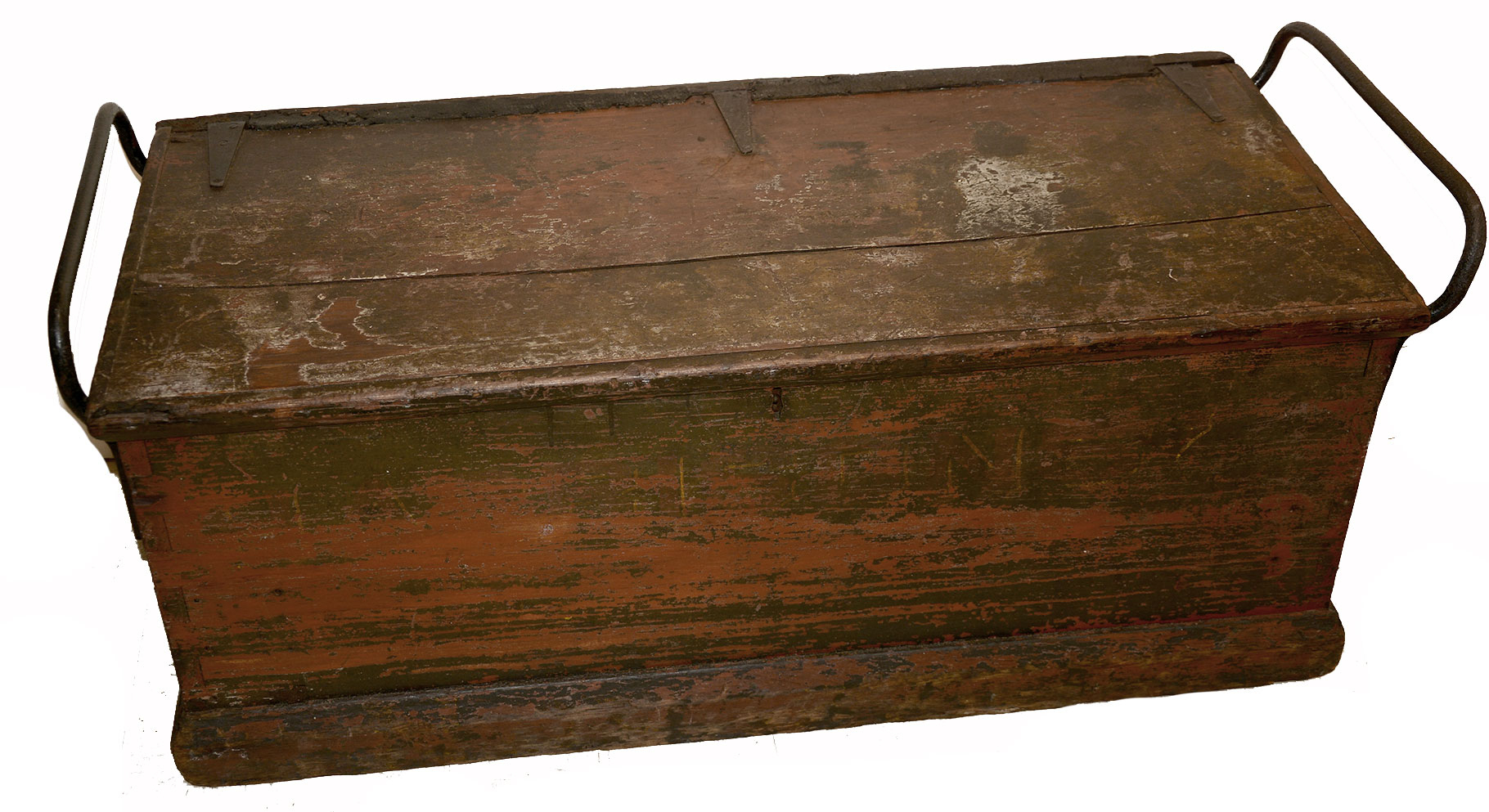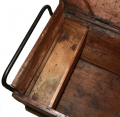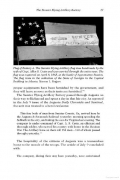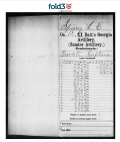site search
online catalog
IMPORTANT IDENTIFIED AND CAPTURED CONFEDERATE LIMBER/CAISSON CHEST

$13,000.00
Quantity Available: 1
Item Code: 2025-297
Shipping: Determined by Method & Location of buyer
To Order:
Call 717-334-0347,
Fax 717-334-5016, or E-mail
Initially one should be aware that limbers carry one ammo chest, caissons carry two. Caissons carry a spare wheel, limbers do not. Limbers are pulled by horses and can be attached to a gun and or a caisson. Caissons are not affixed directly to the gun (see diagram attached). This wooden chest is actually a modified "Valley of Virginia" blanket box and measures 43 ¼” wide x 17 ½” high x 19 ¼” deep. Much of the original overall surface paint is extant. All the remaining iron hardware is original, which includes two small blanket box handles on the sides of the chest. There are three hinges on lid and two large handles on the sides, these were part of the conversion to an ammunition chest. The large handles served to lift the chest and as a hand support for the cannoneers seated on the chest as it was being transported. A leather strap nailed to the top of the lid at the back is covering a crack and was done post-war. There is evidence that a zinc sheeting covered the top/seat typically used on Confederate ammunition chests as opposed to the Union used copper. The hinged lid opens to reveal a small built-in compartment, found on blanket boxes, this is on the left side of chest and was not eliminated by the Confederates in order to store implements. There is a horizontal crack across center of the top of the lid. The iron hardware shows overall light pitting and has now been painted with a rust inhibiting black paint. The partitions which were placed inside the box for projectile separation have been removed. Also, it is apparent that the usually found iron components for mounting the chest to the limber or caisson were removed after capture of the chest; only blind holes and remnants of these remain. The original blanket box's 3-inch-high molding is intact on the bottom of the chest.
A period handwritten inscription found on the inside of the lid reads: "REB’L ART’Y CHEST, CAPTUR'D BY 8TH N.Y. HEAVY ART’Y, PETERSBURG, VA. C. H. WALKER, BOLTON POST NO. 471 G.A.R". Bolton GAR hall was in Troy, New York. Calvin H. Walker the donor, who the inscription is referring to, enlisted at the age of 18 on August 18, 1864, in Plattsburg, New York as a Private. He was mustered into 23rd New York Light Artillery. He was transferred out on December 31, 1864, into the 8th New York Heavy Artillery. He mustered out on June 27, 1865, in Washington, D.C.
When found decades ago this ammunition chest was untouched and uncleaned; it was dirty, and the paint and wood was unstable and subject to future loss. In 2023 the chest was put into the hands of a highly respected collector and restorer. Visible only, prior to this, on both ends of the chest, in 3 inch high professionally executed capital letters, was "SEC. 1". This refers to Section 1. Batteries had sub-divisions, which often translate into the English "platoon" or "troop" with individual ordnance systems called a "section" or "sub-section", where a section comprises two artillery pieces. Upon an extensive surface cleaning followed by stabilization of the painted surfaces the name "LITTLETON" over "SPIVEY" (partial) became manifest on both ends below "SEC.1". Littleton E. Spivey served in the Sumter Flying Artillery of Georgia from 1861 to 1865. Entering service as a private by late 1861 he was soon promoted to lieutenant and ended the war a captain.
Spivey had command of, and was responsibility for, his respective section consisting of two platoons and their equipment two cannon, two caissons, four limbers, and 20 to 30 horses. The section chiefs received their orders from the captain and performed various additional duties such as: brigade/division artillery inspector; requisitioning ammunition, clothing, harness, tools, and tentage; battalion officer of the day. On the march he rode abreast of his section to keep the proper intervals and to check straggling. During battle Spivey sometimes dismounted to direct his section's fire on order of the captain. In the event the captain was absent he took command of the battery. In many instances when he achieved the rank of senior lieutenant took the command permanently. In Spivey's case he became a Senior Lieutenant in May of 1862 and one can assume it was at that time that this ammunition chest was painted with his section and name. Painted across the front of the chest is a hard to read inscription in gold paint about 4 inches high. This possibly reads "SUMTER FLYING ARTY GA". Spivey's history is that of the Sumter Flying Artillery which was composed of five batteries (A through E) and served mostly by men from Sumter County. Aka The11th Battalion of Georgia Light Artillery began organization in early 1861. Initially fighting as part of the army in Northern Virginia from Dranesville, Virginia in December 1861 to the Appomattox campaign in April 1865. We refer you to the book by Speicher: The Sumter Flying Artillery: A civil War History of the Eleventh Georgia Light Artillery.
We now know the whole story on the PETERSBURG capture inscription inside the lid on the box. It was at the breaking of the Confederate lines starting April 1, 1865, that it was captured. This is from the ORs:
"Report of Col. James P. Mclvor, One hundred and seventieth New York Infantry Second Brigade. Hdqrs. Second. Second Army Corps, April 15, 1865.......On the 1st of April the command was advanced still nearer to the enemy (our skirmishers driving those of the opposing force into their breastworks), forming a connection with the Twenty-fourth Army Corps on the run; and at that point also a strong line of works was constructed. During the night of the 1st a force from this brigade, consisting of the Sixty-ninth New York National Guard Artillery, One hundred and fifty-fifth and One hundred and seventieth New York Volunteers, was ordered to assault the enemy’s works, in column of fours, at 4 a. m. the following morning. Everything was prepared accordingly, and the above-named regiments were advanced beyond our skirmish line and close to the enemy’s abatis at 3.30 a. m. At 15 minutes before 4 o’clock the order for the assault was countermanded and the troops were quietly withdrawn. Shortly afterward the enemy made a fierce attack upon the left of the Twenty-fourth Army Corps and also upon our brigade skirmish line. The latter was immediately re-enforced and repulsed the enemy. At 7 a. m. orders were received to assault enemy’s fort, in column of fours, with one-third of the number of men at first detailed. For this purpose, the Sixty-ninth New York National Guard Artillery, under command of Capt. Robert Heggart, was quickly formed upon the skirmish line, and together with the skirmishers, consisting of the One hundred and sixty-fourth New York Volunteers and Company G of the EIGHTH NEW YORK HEAVY ARTILLERY, attacked and captured the fort and works, with TWO GUNS and CAISSONS and many prisoners, in the most gallant manner. The Sixty-ninth New York National Guard Artillery, led by Capt. Robert Heggart, observing another fort directly in rear of the one first attacked and captured, advanced on it and captured it, together with one gun and caisson and many prisoners. The Sixty-ninth New York National Guard Artillery and the One hundred and sixty-fourth New York Volunteers were promptly reformed and sent as skirmishers in pursuit of the enemy, of whom they captured and sent to the rear many. The Sixty-ninth Regiment New York National Guard Artillery was led throughout by Capt. Robert Heggart, whom I would respectfully recommend as deserving of some mark of approbation for his meritorious services. Immediately after the capture of the works the remainder of the brigade advanced and occupied them for a short time, when it was rejoined by that portion which had been skirmishing, after having marched to a point within three miles of Petersburg....The brigade has captured in all above 300 prisoners. I am, major, yours, very respectfully. P. McIvor, Colonel, Commanding Brigade."
Evidently the "two guns" (making a section) and their caissons were taken from the Sumter Flying Artillery in conjunction with the 8th NY Heavy Artillery then acting as infantry. These trophies of war were soon sent North and our caisson chest ended up in Troy NY and GAR Post 471.
This very important artifact is now fully restored and stabilized to museum standards and is actually useable. Its historical importance cannot be overstated. [pe] [ph:L]
Pick-up preferred or special shipping arrangements can be made.
~~~~~~~~~~~~~~~~~~~~~~~~~~~~~~~~~~~
THIS ITEM, AS WITH ALL OTHER ITEMS AVAILABLE ON OUR WEB SITE,
MAY BE PURCHASED THROUGH OUR LAYAWAY PROGRAM.
CLICK HERE FOR OUR POLICIES AND TERMS.
THANK YOU!
Inquire About IMPORTANT IDENTIFIED AND CAPTURED CONFEDERATE LIMBER/CAISSON CHEST
For inquiries, please email us at [email protected]
Most Popular
Historical Firearms Stolen From The National Civil War Museum In Harrisburg, Pa »
Theft From Gravesite Of Gen. John Reynolds »
Selection Of Unframed Prints By Don Troiani »
Fine Condition Brass Infantry Bugle Insignia »
British Imported, Confederate Used Bayonet »
Scarce New Model 1865 Sharps Still In Percussion Near Factory New »
featured item
THE NORFOLK LIGHT ARTILLERY BLUES! IMPRESSIVE HALF PLATE DAGUERREOTYPE BY WHITEHURST IN A WONDERFUL WHITEHURST CASE
This image is not only mounted with a Whitehurst marked mat, but has a full thermoplastic figural case with a purple velvet facing pad embossed with a large eagle flourishing a ribbon reading “J.H. Whitehurst” and holding a shield or plaque with… (1138-1799). Learn More »
site search
Upcoming Events
May 16 - 18: N-SSA Spring Nationals, Fort Shenandoah, Winchester, VA Learn More »















